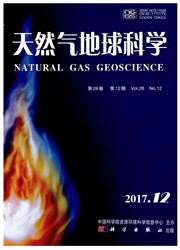

 中文摘要:
中文摘要:
采用压汞测试、低温氮吸附实验方法开展了腐泥煤孔隙特征研究。根据压汞数据分析了不同成熟度腐泥煤的孔隙结构发育情况,揭示了随成熟度增高腐泥煤孔隙结构的变化规律。发现在无烟煤阶段之前,腐泥煤的孔隙结构以微孔、小孔居多;至无烟煤阶段,微孔、小孔比例降低,大孔、中孔含量增加。与同煤阶腐殖煤相比,腐泥煤整体孔隙度较低,且孔径偏小,大孔不太发育。低温氮吸附实验显示,腐泥煤中孔径3.6nm和1.5nm的2种孔隙特别发育,呈现明显峰值,其他孔径孔隙分布较少;液氮吸附滞后回环分析表明,腐泥煤的微孔、小孔形态多样,主要为一端封闭的不透气孔、墨水瓶型孔、平行板状狭缝孔、倾斜板状狭缝孔。上述腐泥煤孔隙结构特征研究成果,对于同样以腐泥型有机质为主的页岩气储层孔隙结构研究具有重要参考价值。
 英文摘要:
英文摘要:
Mercury injection and low temperature liquid nitrogen adsorption experiments were carried out to examine pore structures of the sapropelic coal in this paper. The results of mercury injection demonstrated the pore structure of sapropelic coal with different maturity and revealed the pore change regulation with maturity. Micropore is dominant during the stage before anthracite, while macropore and mesopore are dominant during the peranthracite stage. Compared to the humic coal of the same maturity, the sapropel ic coal has relatively lower porosity and smaller pore size. Furthermore,it is found that micropore with diameter of 1.5nm and 3.6nm are the most dominant. Adsorption hysteresis loop demonstrates the morphological diversity of the micropore,which mainly dominated by airtight pore with one end closed,ink-bottle pore, parallel plate slit pore and inclined slit pore. These findings have great significance on the understanding of physical property of the shale reservoir that is also mainly composed of sapropelic organic matter.
 同期刊论文项目
同期刊论文项目
 同项目期刊论文
同项目期刊论文
 期刊信息
期刊信息
